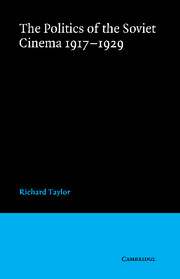Book contents
- Frontmatter
- Contents
- Preface
- Acknowledgements
- Note on transliteration
- Abbreviations
- 1 The pre-history of the Soviet cinema
- 2 The Bolsheviks, propaganda and the cinema
- 3 Revolution and Civil War
- 4 The disorganisation of organisation: the early twenties
- 5 The organisation of disorganisation: the later twenties
- 6 The Party takes control
- 7 Theory and film
- 8 Conclusions
- Notes
- Bibliography
- Index
1 - The pre-history of the Soviet cinema
Published online by Cambridge University Press: 07 October 2011
- Frontmatter
- Contents
- Preface
- Acknowledgements
- Note on transliteration
- Abbreviations
- 1 The pre-history of the Soviet cinema
- 2 The Bolsheviks, propaganda and the cinema
- 3 Revolution and Civil War
- 4 The disorganisation of organisation: the early twenties
- 5 The organisation of disorganisation: the later twenties
- 6 The Party takes control
- 7 Theory and film
- 8 Conclusions
- Notes
- Bibliography
- Index
Summary
I consider that the cinema is an empty, totally useless, and even harmful form of entertainment. Only an abnormal person could place this farcical business on a par with art. It is complete rubbish and no importance whatsoever should be attached to such stupidities
Nicholas II, 19131895–1916: CHILDHOOD AND ADOLESCENCE
When the October Revolution took place in 1917 the cinema was still less than a quarter of a century old. Man's centuries of effort to create a ‘living picture’ had culminated in the Lumiere brothers' cinematograph machine. Previous inventions had required the spectator to look into a box to observe the image, but the cinematograph involved the projection of a moving image on to a screen; hence, with duplicated film prints, the same spectacle could, at least in theory, be enjoyed simultaneously by an infinite audience throughout the world. The age of the mass media had arrived.
Although the cinema's origins were more recent than those of the other media of the Revolution (posters, newspapers, political meetings, inter alia), its development was much more rapid. As a Soviet critic of the 1920s wrote:
Two paths.
One is long and stretches through the centuries: the other is short and triumphant, rushing from one victory to another in a quarter of a century.
The path of the cinematograph and the path of the cinema.
The path of a technical invention for the demonstration of living, moving photography.
And the path of a new art, different from all the others – the Art of the Cinema.
- Type
- Chapter
- Information
- The Politics of the Soviet Cinema 1917–1929 , pp. 1 - 25Publisher: Cambridge University PressPrint publication year: 1979



